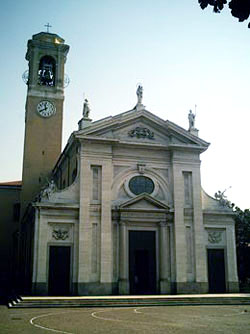Description

The sides
are decorated with plasters, paintings and valuable wall paintings. A
beveled
octagon with six really big rose marble columns hold the nave. Walking
along
the nave in the third chapel on our left,
we can admire the Saint Antony Abbot chapel. In this chapel
there is a
painting of the brothers Lampugnani, dated 1644, that represent a
procession
lead by the archbishop and some others authorities. This procession
remind us
the one that until 1586, started from
Now let's
have a look at the altar, made of
baroque wood by an anonymous sculptor, it's six meter long and with 3
floors. In the first one it's represented the Emmaus' Supper that
remind us the
Eucharist . In the second one we can see the Virgin' Glorification, and
in the
last one there's the Resurrection of Christ. In the upper part, like a
crown
there are little spiral column with interwoven ivy and statues
representing
Apostles, Martyrs, Confessors and Virgins. Unfortunately we cannot know
the
artist that had thought about it, neither the maker. Walking along the
nave, at
the half part of the right aisle we must notice the Chapel of the Holy
Family,
in which are present the wall painting of the Saint Patron Gervaso and
Protaso.
This two characters, tells the legend, could be twins. At the death of
the
parents, they sold the property and released all the slaves, to shouted
themselves away in a hovel where they had been praying for ten years. A
man
called Astasio tried to convert them, cause he wanted the benediction
of the
Gods in occasion of a military campaign against the Marcomairanni
Barbarian. He
was no successful and as a revenge, he killed the two brothers. Grevaso
died
flagellated while Protaso was beheaded
with a stroke of ax. Nowadays we are only sure about the retrieval of
the
bodies thanks to Saint Ambrogio. At the
end of this aisle we can admire the fabulous organ Carrera built in
1841 by
Girolamo Carrera.









